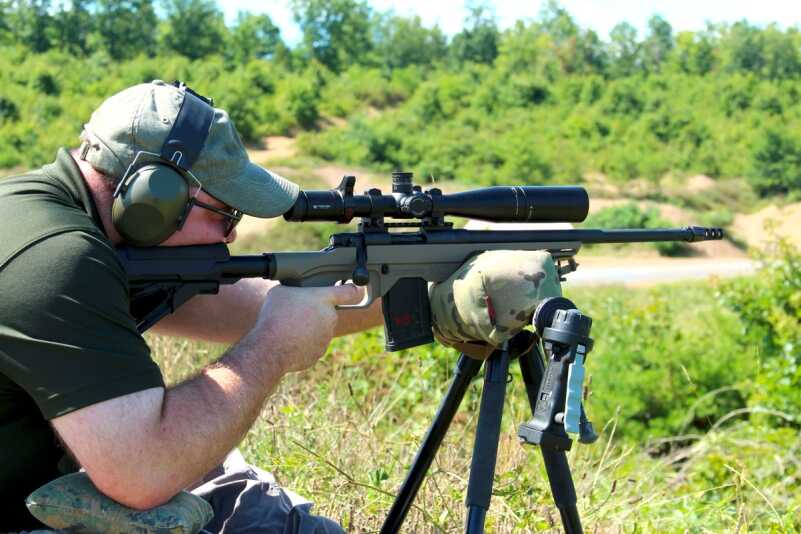
The Mossberg MVP-LC features an aluminum chassis that accepts AR-pattern parts, and the rifle feeds from AR-pattern magazines. The result is a uniquely capable tactical and/or precision rifle that can be had in 5.56 or 7.62 NATO chamberings.
To learn more, visit https://www.mossberg.com/.
To purchase on GunsAmerica.com, click this link: https://www.gunsamerica.com/Search.aspx?T=MVP%20LC.
It wasn’t that long ago that Mossberg was best known for tough and dependable pump-action shotguns for hunting and tactical use. Eventually they started producing bolt-action hunting rifles and offered the MVP line of rifles, later expanding to include the MVP Long Range and Light Chassis rifles at the 2015 SHOT show that took the MVP line to a new level for those wanting to get into long-range shooting.

The Mossberg MVP-LC is offered in a 7.62/.308 version and can be bought as a package equipped with a Vortex optic. Image courtesy of manufacturer.

The MVP-LC is also offered in 5.56/.223. A folding bipod comes standard on both models. Image courtesy of manufacturer.
The Light Chassis series includes 5.56mm and 7.62mm variants that feed from AR-pattern, detachable magazines. That being said I have before me both the 5.56 and the 7.62 versions of their Light Chassis system, and I say system because it can be purchased as a package deal that includes a Vortex optic in addition to a Caldwell bipod that comes standard that helps make this rifle a very appealing turn-key option (you can also buy the rifles without the optic). I can honestly say this is the first rifle series in a long time that I was genuinely excited to shake out.

The rifle employs an aluminum chassis that makes it well-suited to not only long-range work but also tactical roles. Image courtesy of manufacturer.
SPECS (5.56 & 7.62)
- Chambering: 5.56mm NATO or 7.62mm NATO
- Barrel: 16.25 inches or 18.5 inches
- OA Length: 35.5 inches or 37.75 inches
- Weight: 10 pounds
- Stock: Aluminum light chassis
- Sights: Vortex Viper HS-T 4-16X
- Action: Bolt-action
- Finish: Matte blue
- Capacity: 10+1
- MSRP: $1,995 ($1,365, without optic)
Rifle Overview
At the heart of MVP-LC is Mossberg’s MVP action that is based on the 4X4 action but designed to reliably strip rounds from a standard-pattern AR magazine (AR-15 for 5.56 and LR308/SR25 for the 7.62). The bolt body is fluted with a teardrop bolt knob that is easy to grasp for quick bolt manipulations, and the action employs a push-feed system. The barrel is chambered in 5.56 NATO with a twist rate of 1:7 inches or 7.62 NATO with a 1:10 rate of twist. In regards to the 5.56 NATO rate of twist, I think this is fantastic news for long-range shooters that want to push the heavier 75- and 77-grain bullets. The 5.56 NATO chamber also ensures that just about any .223 Remington and 5.56 NATO ammunition that can fit in the magazine can be safely fired from the rifle. The barrel contour of the rifles is also not as heavy as something like a Remington Varmint but also not as light as a standard Sporter contour barrel. At the end is a SilencerCo muzzle brake that can also be removed and replaced with a thread protector if you do not wish to have a muzzle brake on the rifle or need to use a direct thread-on suppressor.

The SilencerCo muzzle brake is standard equipment on the MVP-LC. If you do not wish to have a muzzle brake, it is easily removable and replaced with a thread protector.
There are some slight differences between the 5.56 and 7.62 models, but their basic configuration is just about the same. The action itself on the 7.62 version is similar to the 5.56 action, but it is larger and has a longer overall length, which shouldn’t be that surprising considering the action has to handle the larger 7.62 round. The 7.62 action distinguishes itself from its little brother in the way the rounds are picked up from the magazine. Instead of using a steel flap like on the 5.56 bolt, the 7.62 has two small lugs on the bottom of the bolt that act in a similar way as the lugs on a 7.62mm AR bolt. These lugs move along two corresponding slots in the action and the feed ramp during the cycling process. You also get about two more inches of barrel on the 7.62 version compared to the 5.56 MVP LC, but it features the same SilencerCo muzzle brake for recoil reduction, albeit designed for .30-cal rifles. The 1:10 twist rate ensures that it can easily stabilize most common .308 Winchester ammunition.
[one_half]
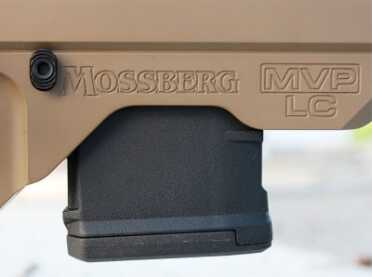
The standard AR-15 magazine release and magazines of the 5.56 version means the shooter can count on a reliable and proven system.
[/one_half]
[one_half_last]

The 7.62 MVP-LC feeds from LR308/SR25-pattern magazines and comes standard with a 10-round Magpul PMAG.
[/one_half_last]
The MVP-LC is equipped with Mossberg’s Lightning Bolt Trigger system that features a trigger blade that blocks the sear from releasing the firing pin until it is fully depressed. Some may look at this feature and see its similarities to Savage’s trigger system, but I would say that the Mossberg trigger blade is not as pronounced, nor as finicky in my opinion. This safety feature means that the rifle is designed to not fire without the trigger blade and trigger being depressed. The trigger is user adjustable from two to seven pounds by turning a screw on the front of the trigger housing with a common flat-bladed screwdriver. I tried the 5.56 NATO rifle and found that the trigger consistently broke at about two pounds using my RCBS trigger pull gauge; not too bad for an off-the-shelf rifle.
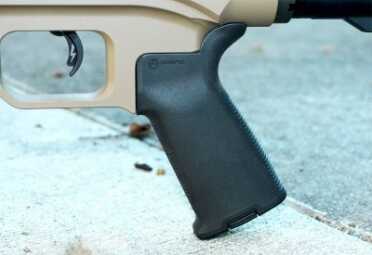
The MOE grip provides a sure grip in any condition and the adjustable “Lightning” trigger came in a svelte 2-pound pull out of the box.
Mossberg’s main departure from their other rifles in the MVP line-up is the use of an aluminum chassis system that adds the modular capabilities of an AR-pattern rifle to a bolt-action rifle. The chassis is rollmarked Mossberg, but they are actually made by a company called Modular Driven Technologies that makes similar chassis for a variety of other rifle actions. The chassis is made from aircraft grade aluminum and finished in a Cerakote FDE color that is extremely chemical and wear resistant. The chassis comes furnished with a suite of Magpul accessories including a Magpul CTR collapsible stock with cheek riser on a buffer tube extension, Magpul MOE+ Grip and a Magpul 10-round PMAG. Since the chassis uses standard AR parts, many of these factory supplied parts can be easily swapped out at the user’s discretion.
As part of the complete Light Chassis system, Mossberg also supplies a Vortex Viper 4-16x44mm HS-T scope with the 5.56mm version as well as a Caldwell 6”-9” bipod on both base and package rifles. The scope has both a mil-based reticle and matching turrets, which tells me that Mossberg has been paying attention to the market and is including a scope that a shooter would actually want. The optic isn’t the best of the line-up, but it is a great scope for this application. It is easy to zero, it has a good magnification range for everything from hunting to target shooting, and the image quality is more than sufficient; in essence a great mid-level scope. Another aspect of the scope is that it is backed by Vortex Optics’ famous VIP warranty which basically states that if it breaks Vortex will fix it. It’s hard to argue with that. Now, the bipod is not the best one on the market, but it is serviceable and I appreciated it had notched legs that were easy to adjust while still in position behind the rifle.
Devil’s In The Details
While theoretically the MVP-LC is ready to shoot out of the box, I approached these rifles just as if I’d purchased them myself and brought them home for the first time. I took about an hour to check all of the fasteners, check the scope, and make sure that the rifles were functioning safely. I do this to mitigate any surprises I might encounter out on the range and make sure that my trip is as successful as possible. It’s no fun to be chasing your tail and wasting your ammunition while trying to get a zero only to realize that your scope rings are loose. While I was disassembling the rifles, I did take note of a couple of interesting things when it came to assembly and function. None of the items are serious but just a few observations that one should be aware of when they get their own MVP Light Chassis rifle.
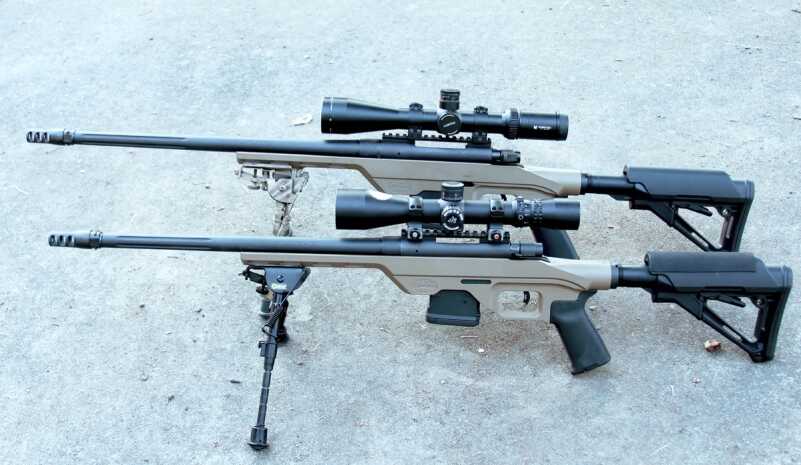
The two version of the MVP-LC are roughly comparable in size, with the 5.56 (front) featuring a slightly shorter barrel and action than the 7.62 (rear).
One of the first things that I noticed was that the fasteners did not appear to be torqued to any sort of common standard for action screws or optic fasteners. This is not to say that they were loose; in fact, every fastener that I inspected was more than tight enough to prevent recoil or shock from jarring them loose. However, I’m a stickler for specs, so I went ahead and loosened all of them up and torqued them to their respective manufacturer’s recommended settings.
[one_half]

The unique MVP bolt head is designed to reliably strip rounds from a standard AR-15 magazine. The key is the steel flap that hangs down to catch the round, then pivots up in battery.
[/one_half]
[one_half_last]

Instead of using a steel flap like on the 5.56 bolt, the 7.62 has two small lugs on the bottom of the bolt that act in a similar way as the lugs on a 7.62mm AR bolt.
[/one_half_last]
Now, when it came to magazines things got a little more interesting but nothing that is really new to anyone familiar with using a detachable box magazine-fed rifle. I found the magazine well of the 5.56 chassis to be really tight with some magazines and perfectly smooth with some others. The supplied 10-round PMAG and Lancer 20-round magazines that I had fit just fine and worked perfectly. However, my aluminum 20-round magazines, my 30-round PMAGs and some of my aluminum GI magazines were very tight in the magazine well. The rifle fed from all of the magazines just fine, so functionality was 100%, you just had to really shove them in there. I also learned along the way that differences in magazine followers will determine if you can single feed rounds into the action or not. Both the Lancer and Magpul ten round magazines allowed me to single feed, but 30-round PMAGs would essentially lock the bolt back. On the 7.62mm model, I had no problems with the included 10-round Magpul PMAG, which fit cleanly and installed and removed easily.
Perfect the Enemy of the Good?
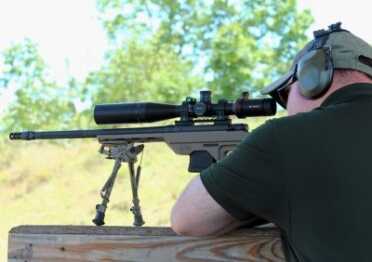
The clear, crisp optics, comfortable chassis system, and highly effective muzzle brake made for a very soft shooting rifle that was no trouble at all from the bench.
After learning the little ins and outs of these rifles, I was ready to head out to the range to start putting them through their paces. I tried to select a variety of ammunition that would highlight the rifle’s abilities as not only a long-range target rifle but also as an effective varmint rifle as well. Amongst the five different types of ammunition that I had to shoot, I used Federal’s 69-grain Gold Medal Match, Hornady’s 75-grain Match and Hornady’s 55-grain Z-Max ammunition. For the 7.62mm, I used some 175-grain Match ammunition I had on hand from Southwest Ammo. All zeroing was performed at 100 yards from a bench with a bipod on the front and a simple rear bag rest; no lead sleds or benchrest set ups here. I used the same Vortex scope on both rifles.
I will get to the results a little farther down but I’m not going to mince words: If you are looking for a ½ MOA precision rifle, this may not be the one for you. However, if you are looking for a versatile and accurate rifle that’s quite capable out to extended ranges then, by all means, please continue reading. In the interest of my treating these like they were any one of my other rifles, I gathered my ammunition, my targets, and chronograph to head to the range to get a zero at 100 yards.
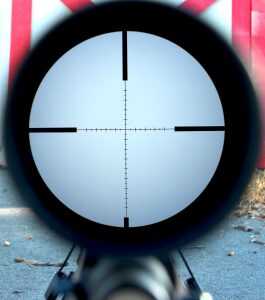
The simple but effective mil-based reticle in the Vortex Viper HS-T is perfect for those learning how to use mils for the first time.
As I had a lot more .223 ammo on hand, I started out with the 5.56 rifle. During this first range trip I came to an interesting observation; despite the 1:7 twist of the 5.56mm, which should have favored the heavier match ammunition, that rifle seemed to prefer lighter bullets. That range visit the Federal Gold Medal Match tied the Hornady Z-Max for accuracy, but it was probably the most consistent ammunition out of the bunch. I went back to the range a second time to see if I could improve on the groups at 100 yards using the Federal and Hornady ammunition. The Federal Gold Medal Match shot the best, which basically confirmed for me that the rifle loves this ammunition. I improved the group size from previously with the Hornady 75-grain Match and the group for the Hornady 55-grain Z-Max basically stayed the same. With Federal Gold Medal Match, I’d say that the 5.56mm rifle will do 1 MOA on a consistent basis, otherwise the rifle is solid 1.5 MOA rifle. I don’t think that’s necessarily horrible, perhaps a little larger than I’m used to but I also recognize that some 100-yard groups don’t tell the whole story of whether or not a rifle is any good.
With the 7.62mm, the best five shot group of the Southwest Ammo at 100 yards measured 1.68″ overall, even though four of the five were within less than 1″ of each other. I believe that with a little more time behind the gun and some other bullet weights the groups could shrink more. The muzzle velocity was measured with a MagnetoSpeed Sporter chronograph at 2,539 fps, and that’s pretty respectable for a short-barrel .308.
 I can be ok with a rifle not shooting 1/2 MOA groups at 100 yards, but if it can’t hit practical sized-targets at range then I have no use for it. Moving on from 100 yards with the 5.56 I shifted to the 200 and 300-yard steel targets and I feel that this is where the 5.56mm rifle really started to grow on me. In this instance, the most practically sized targets at 200 and 300 yards were about four to six inches wide, the other ones were about 18-inches wide, which I’m pretty sure I could’ve hit with my eyes closed. Between the Federal and Hornady ammunition, each one of them was capable of stacking the rounds on top of one another until there was just one big black spot on the target. It was not possible for me to go downrange and get accurate group size measurements, but by using the reticle I could deduce that they were hovering right around a 1 – 1.5 MOA group size. Taking out some errant clay birds laying on the back of the 300-yard berm was also no large feat and in what seemed like no time I had cleared the berm. I was able to shoot the rifle at 600 yards where the rifle had no trouble shooting the 12-inch hanging plates or the IPSC target. When I moved to the 7.62mm at these ranges, it didn’t really reveal any surprises on steel; any misses were my fault while I was trying to work out my drops. That .308 hit with authority though, ringing the steel like music to my ears.
I can be ok with a rifle not shooting 1/2 MOA groups at 100 yards, but if it can’t hit practical sized-targets at range then I have no use for it. Moving on from 100 yards with the 5.56 I shifted to the 200 and 300-yard steel targets and I feel that this is where the 5.56mm rifle really started to grow on me. In this instance, the most practically sized targets at 200 and 300 yards were about four to six inches wide, the other ones were about 18-inches wide, which I’m pretty sure I could’ve hit with my eyes closed. Between the Federal and Hornady ammunition, each one of them was capable of stacking the rounds on top of one another until there was just one big black spot on the target. It was not possible for me to go downrange and get accurate group size measurements, but by using the reticle I could deduce that they were hovering right around a 1 – 1.5 MOA group size. Taking out some errant clay birds laying on the back of the 300-yard berm was also no large feat and in what seemed like no time I had cleared the berm. I was able to shoot the rifle at 600 yards where the rifle had no trouble shooting the 12-inch hanging plates or the IPSC target. When I moved to the 7.62mm at these ranges, it didn’t really reveal any surprises on steel; any misses were my fault while I was trying to work out my drops. That .308 hit with authority though, ringing the steel like music to my ears.
I did a quick ballistic comparison of the bullet drops for both rifles out to 600 yards as shown in the chart above. What I found interesting is that even at 600 yards the bullet drops are within 2″ of each other, despite the caliber and bullet difference. Granted, the .308 is going to pack more of a punch at any of the listed ranges because as we know there is no replacement for displacement. In terms of just punching paper or clanging steel though, a quick .223 can run neck and neck with a relatively slow .308.

I enjoyed my time with both rifles because they were fun, accurate, and packed with features that I think add real value to the consumer. I believe these rifles could fill a niche in just about any category from hunting to target shooting to law enforcement use. In fact, in the process of testing these rifles, I gained a better appreciation for how the rifle is built, its components, and also the rifle’s capabilities and limitations. I’m sure some people would look at this rifle and the MSRP and balk at the seemingly high cost, but I think if you step back and see what you’re getting for that money, it’s really not that bad. Plus, if you shop around I know you can find this rifle package for well under the MSRP. At the end of the day, the Mossberg MVP Light Chassis is an accurate and reliable rifle that is a good choice for the field and the range to go after whatever target may be in front of you.
To learn more, visit https://www.mossberg.com/.
To purchase on GunsAmerica.com, click this link: https://www.gunsamerica.com/Search.aspx?T=MVP%20LC.


Does any one know if that mossberg MVP chassis will fit the mossberg patriot in 308 , I’m looking to up grade the stock , looked a Boyd’s ,,just don’t do it for me ,, I’d appreciate any help ,,thank you
I have owned three MVP variants, one of which had the lightweight chassis. I purchased it from a guy that replaced the stock with the chassis system. All three were incredibly accurate – I got sub MOA. But, I could never get over the sloppiness of the bolt – it’s terrible!!! In addition, the resale value sucks on these. Expect to get 30% to 40% of what you paid. IMHO, they should ditch the AR mag compatibility and just develop a chassis system with a smooth and tight bolt that is sub MOA. Just my $.02.
The sloppy bolt is not a result of AR mag compatibility. I had a Mossberg MVP rifle in .270 that fed from a blind mag and the bolt to receiver fit in that gun was awful also. It’s just how Mossberg builds their rifles apparently.
I see these articles as nothing more than paid advertisements.
They pay for the exposure in ammo and gear with the hope it sells their overpriced products.
It’s almost as bad as the auto magazines having articles and test drives on $300,000 cars.
I have yet to see a new $300 bolt gun with a sub $100 scope and tested shooting only off the shelf cheap ammo.
The only gun I have in my possession that cost more than $500 was the Sig P238 my daughter purchased.
None of my AR’s (15 and 308) were built for over $500, including the optic.
Cheap, frugal, or affordable, it’s all in point of view.
I almost bought one of these earlier this year. Just couldn’t get over the “sloppiness” of the bolt. Called Mossberg twice and asked about it. Got the runaround and we will call you back. So I emailed them and got the same thing. Ended up buying the Ruger Precision. Very happy with it.
why is it called “light chassis”? whats light about it? not the rifle…. not the price tag..
My Ar is heavier than most ( All Billet and 18″ heavy barrel ) and weighs about the same as this mossberg, does this mean I can start calling my AR a light chassis? at least it would be fun to see their faces as they realize it’s not light at all and heavier than their AR’s
The Long Range model is lighter than the Light Chassis. I shoot but I’m not knowledgeable as folks that post. Anyone help me understand why the LR is 7-8 lbs and LC 8-10 lbs? Why would I purchase the LC if the LR is lighter!
Thanks,
Doug
I think if some was looking for the best of both worlds an AR Hybrid/Bolt action AR would look at Riverman gun works in Idaho, imho….
I believe the article that was posted on 5-2016 about the Ruger precision rifle is a far superior rifle for $900.00. Thank you for the interesting test article nevertheless.
Let’s not forget these are NATO chambered barrels. Running plain 223 and 308 ammunition in them is not going to be as accurate. The ammo may be consistant, but not to the full potential that a 223 or 308 chambering would be. Plus the barrels really need 150 rounds run through them to season the bores before one starts seeing the best out of it.
So we have a bolt action rifle in 308 that shoots an 1-1/2″ at 100yds for the MSRP of nearly $2000.00. I have factory Ruger, Remington and Winchester bolt action rifles that do that or better and I paid around $500.00 for them when I bought them. I have built bolt guns on 17 Enfields and large ring Mauser that shoot just as well. Not to mention there is not an AR in this household that doesn’t do under an 1″ at 100yds with a scope. All purchased for considerably less than the rifles in this article. $2000.00 for a ten pound rifle that shoots 1-1/2 ? I would be awfully disappointed with that.
I can’t understand all the hoopla. I have built several ARs with relatively inexpensive barrels that grouped under 1/2 in for five shots at 100 yds and 2.25 in for five shots at 300 yds. maybe I’m missing something.
This is a bolt gun, which leads to the inevitable question: Why does it have a (useless) recoil tube? Wouldn’t a sold stock be a better choice?
The recoil tube as you call it allows the use of the many types of adjustable AR stocks available. I like this.
So you can run standard AR stocks. Some kind of folding feature may be better though.
Could it be because it’s such a modular system that later if you chose to you could put a stock more to your liking? Or as I’m going to do when I get one, put the folding stock hinge on so it’ll be more compact during transport.
Sure put that LAW adapter on there for a folding stock, there’s another $200 into the gun…if it will work.